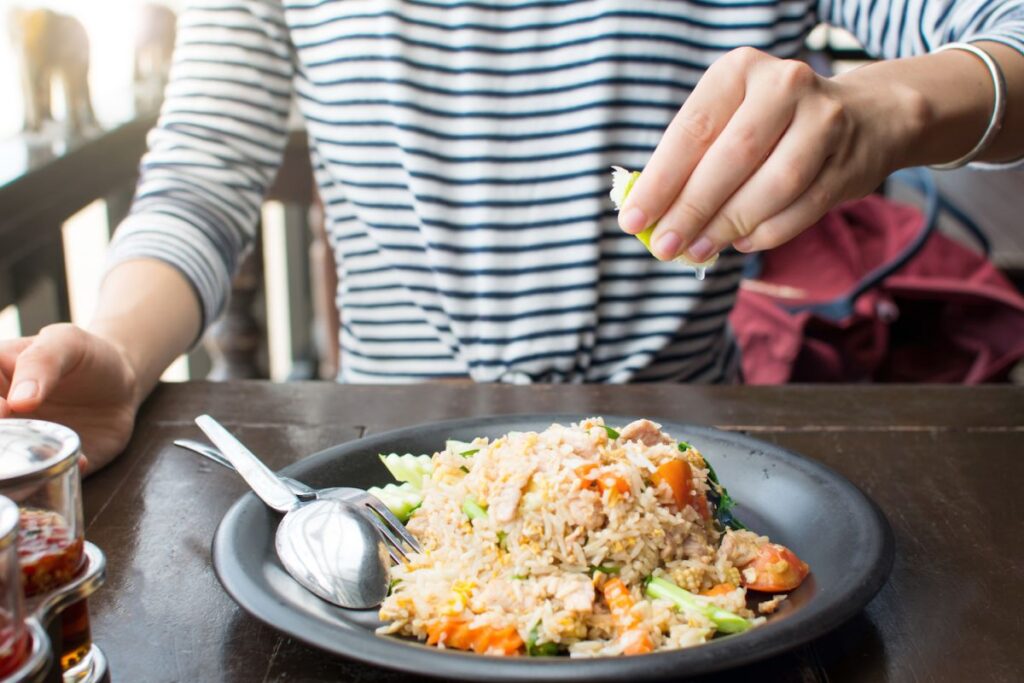Uncooked rice can contain spores of Bacillus cereus, bacteria that can cause food poisoning. The spores can survive when rice is cooked. If rice is left standing at room temperature, the spores can grow into bacteria. These bacteria will multiply and may produce toxins (poisons) that cause vomiting or diarrhoea.
What illness is linked with cooked rice?
Bacillus cereus is a toxin-producing bacteria that is one of the most common causes of food poisoning, also called “fried rice syndrome.” An estimated 63,000 cases of food poisoning caused by B.
What bacteria is found in cooked rice?
Rice is more problematic than some other leftover foods as it may contain bacteria called Bacillus cereus, which survive some cooking processes . This bacterium is often the cause of food poisoning from reheated or cooked rice.
What are the signs and symptoms of Bacillus cereus?
The symptoms of B. cereus diarrheal type food poisoning include abdominal pain, watery diarrhea, rectal tenesmus, moderate nausea that may accompany diarrhea, seldom vomiting and no fever. Symptoms develop within 6-15 hrs and can persist for 24 hrs.
What illness is linked with cooked rice?
Bacillus cereus is a toxin-producing bacteria that is one of the most common causes of food poisoning, also called “fried rice syndrome.” An estimated 63,000 cases of food poisoning caused by B.
What happens when you eat too much cooked rice?
Consumption of rice is likely safe. However, eating white rice in excess amount on a daily basis can boost high risk for developing type 2 diabetes and obesity. Hence a balanced diet should be maintained.
What is rice disease?
The disease occurs in circular to irregular areas in fields and causes premature death and lodging of the plants. The fungus attacks the rice plant near the water line usually during late tillering or early reproductive stages of growth.
Why should you not reheat rice?
Rice can contain spores from a type of harmful bacteria. If cooked rice is left at room temperature, the bacteria could start growing again from the spores. These bacteria will multiply and may produce toxins (poisons) that cause food poisoning. Reheating will not get rid of these.
What pathogen is most associated with rice?
Rice can be a source of food poisoning because it can be contaminated with dangerous pathogens. Pathogens that often transmitted through rice are Bacillus cereus and Staphylococcus aureus.
How do you get rid of Bacillus cereus?
cereus: Steaming under pressure, roasting, frying, and grilling foods will destroy the vegetative cells and spores if temperatures within foods are ≥ 145ºF (63ºC).
What food can Bacillus cereus be commonly found in?
As B. cereus is found in soil, raw plant foods such as rice, potatoes, peas, beans and spices are common sources of B. cereus.
What are the first signs of listeria?
The symptoms vary with the infected person: Higher-risk people other than pregnant women: Symptoms can include fever, muscle aches, headache, stiff neck, confusion, loss of balance, and convulsions. Pregnant women: Pregnant women typically experience only fever, and other non-specific symptoms like chills and headache.
Which two foods are commonly associated with Bacillus cereus?
This syndrome is frequently associated with starchy food such as pasta or rice dishes. The diarrhoeal syndrome occurs when a large number of vegetative cells of B.
Why is it called fried rice syndrome?
One of the most common bacteria found in fried rice is Bacillus cereus. It is a spore-forming bacterium also commonly found in soil and the environment. Upon contamination, these bacteria can grow in the food and produce toxins that can cause food poisoning – this is known as the “fried rice syndrome”.
What bacteria is the most common cause of food poisoning?
Food poisoning is an illness caused by eating contaminated food. It’s not usually serious and most people get better within a few days without treatment. In most cases of food poisoning, the food is contaminated by bacteria, such as salmonella or Escherichia coli (E. coli), or a virus, such as the norovirus.
What are the disease symptoms of rice?
Bacterial blight is caused by Xanthomonas oryzaepv. oryzae (Xoo) and affects the rice plant at the seedling stage where infected leaves turn grayish green and roll up. As the disease progresses, leaves turn yellow to straw-colored and wilt, leading whole seedlings to dry up and die.
What causes rice syndrome?
One of the most common bacteria found in fried rice is Bacillus cereus. It is a spore-forming bacterium also commonly found in soil and the environment. Upon contamination, these bacteria can grow in the food and produce toxins that can cause food poisoning – this is known as the “fried rice syndrome”.
How common is Bacillus cereus in rice?
The prevalence of B. cereus detected in cooked rice at consumption point was 37.5%. Production types, final temperature at cooking, and consumption phases were associated with contamination level of B.
What illness is linked with cooked rice?
Bacillus cereus is a toxin-producing bacteria that is one of the most common causes of food poisoning, also called “fried rice syndrome.” An estimated 63,000 cases of food poisoning caused by B.
Why we should not eat rice in dinner?
When you eat rice for dinner, this instant spike in energy is created as the food is digested easily but because you are going to be asleep for the next few hours, your body will not get any nutrition for these many hours.
Can rice cause digestive problems?
Rice is a good source of energy and protein, but not all grains are easy to digest. High fiber rice, such as brown rice, can contribute to digestive issues, including diarrhea, bloating, and gas.
Can you get sick from eating overcooked rice?
Adding flavor to cooked rice is easy because the grain absorbs herbs, spices and liquids readily. Overcooked rice can however, pose a health hazard that includes nutrient depletion and increased risk of cancer.









